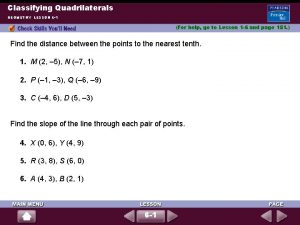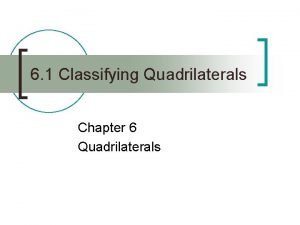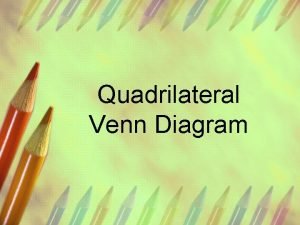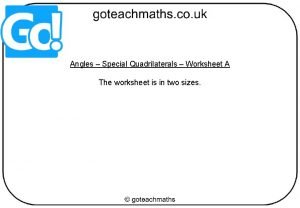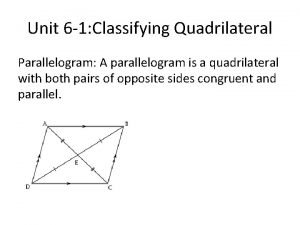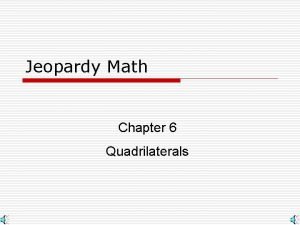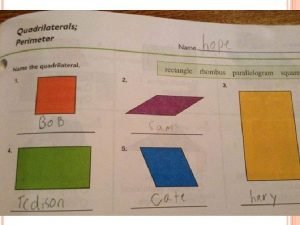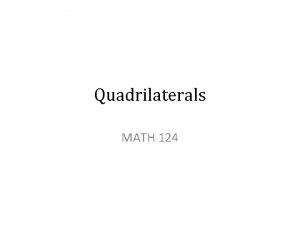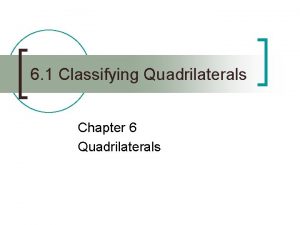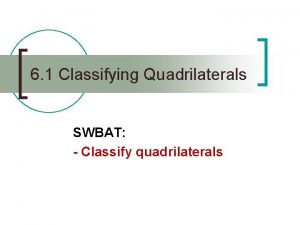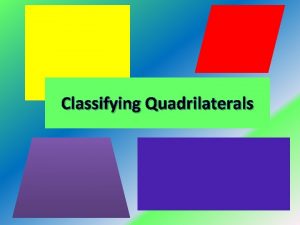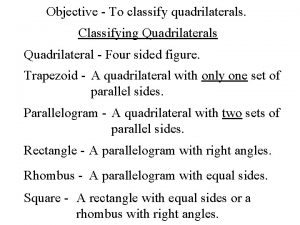Classifying Quadrilaterals Lesson 6 1 Geometry Notes A









- Slides: 9

Classifying Quadrilaterals Lesson 6 -1 Geometry Notes A quadrilateral is a polygon with four sides. A parallelogram ( ) is a quadrilateral with both pairs of opposite sides parallel. A rhombus is a with four congruent sides. A rectangle is a with four right angles. A square is a with four congruent sides and four right angles. Lesson Main Lesson 6 -1 Feature

Classifying Quadrilaterals Lesson 6 -1 Geometry Notes A kite is a quadrilateral with two pairs of adjacent sides congruent and no opposite sides congruent. A trapezoid is a quadrilateral with exactly one pair of parallel sides. An isosceles trapezoid is a trapezoid whose nonparallel sides are congruent. Lesson Main Lesson 6 -1 Feature

Classifying Quadrilaterals Lesson 6 -1 Geometry Notes Lesson Main Lesson 6 -1 Feature

Classifying Quadrilaterals Lesson 6 -1 Geometry Additional Examples Classifying a Quadrilateral Judging by appearance, classify ABCD in as many ways as possible. ABCD is a quadrilateral because it has four sides. It is a trapezoid because AB and DC appear parallel and AD and BC appear nonparallel. Quick Check Lesson Main Lesson 6 -1 Feature

Classifying Quadrilaterals Lesson 6 -1 Geometry Additional Examples Classifying by Coordinate Methods Determine the most precise name for the quadrilateral with vertices Q(– 4, 4), B(– 2, 9), H(8, 9), and A(10, 4). Graph quadrilateral QBHA. First, find the slope of each side. slope of QB = 9– 4 5 = – 2 – (– 4) 2 slope of BH = slope of HA = 9– 9 =0 8 – (– 2) 4– 9 5 = – 10 – 8 2 slope of QA = 4– 4 =0 – 4 – 10 BH is parallel to QA because their slopes are equal. QB is not parallel to HA because their slopes are not equal. Lesson Main Lesson 6 -1 Feature

Classifying Quadrilaterals Lesson 6 -1 Geometry Additional Examples (continued) One pair of opposite sides are parallel, so QBHA is a trapezoid. Next, use the distance formula to see whether any pairs of sides are congruent. QB = ( – 2 – ( – 4))2 + (9 – 4)2 = 4 + 25 = HA = (10 – 8)2 + (4 – 9)2 = BH = (8 – (– 2))2 + (9 – 9)2 = 100 + 0 = 10 QA = (– 4 – 10)2 + (4 – 4)2 = 196 + 0 = 14 4 + 25 = 29 29 Because QB = HA, QBHA is an isosceles trapezoid. Lesson Main Lesson 6 -1 Quick Check Feature

Classifying Quadrilaterals Lesson 6 -1 Geometry Additional Examples Using the Properties of Special Quadrilaterals m In parallelogram RSTU, m S = 3 x + 50. Find x. Draw quadrilateral RSTU. Label RSTU is a parallelogram. ST || RU m R + m S = 180 Lesson Main R and R = 2 x – 10 and S. Given Definition of parallelogram If lines are parallel, then interior angles on the same side of a transversal are supplementary. Lesson 6 -1 Feature

Classifying Quadrilaterals Lesson 6 -1 Geometry Additional Examples (continued) (2 x – 10) + (3 x + 50) = 180 5 x + 40 = 180 5 x = 140 x = 28 Substitute 2 x – 10 for m R and 3 x + 50 for m S. Simplify. Subtract 40 from each side. Divide each side by 5. Quick Check Lesson Main Lesson 6 -1 Feature

Classifying Quadrilaterals Lesson 6 -1 Geometry Lesson Quiz Judging by appearance, classify the quadrilaterals in Exercises 1 and 2 in as many ways as possible. 1. 2. quadrilateral, kite quadrilateral, parallelogram, rectangle, rhombus, square 3. What is the most precise name for the figure in Exercise 1? 4. What is the most precise name for the figure in Exercise 2? square kite 5. Find the values of the variables in the rhombus to the right. a = 60, x = 6, y = 2 Lesson Main Lesson 6 -1 Feature
